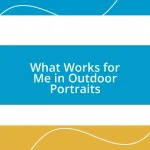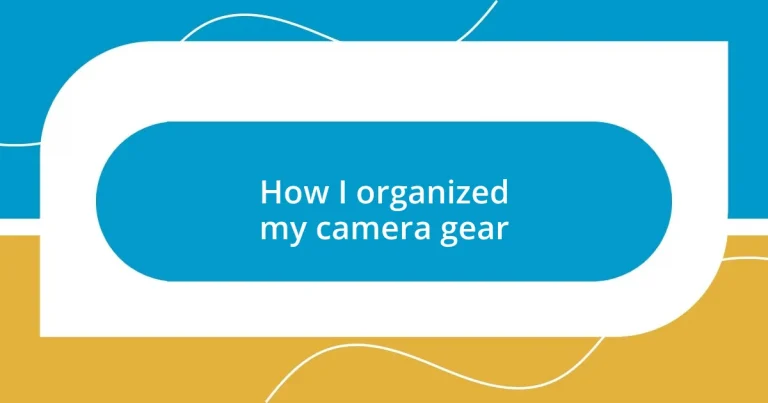Key takeaways:
- Assessing the camera collection evokes nostalgia and highlights the importance of utilizing gear fully instead of letting it become decor.
- Choosing the right storage solution enhances accessibility, protection, and organization of gear, greatly improving the photography workflow.
- Organizing gear by type and labeling items fosters creativity and efficiency, making it easier to find and use equipment for shoots.
- Regularly reviewing and updating the setup allows for personal growth and alignment with current creative pursuits, ensuring the gear remains relevant and inspiring.
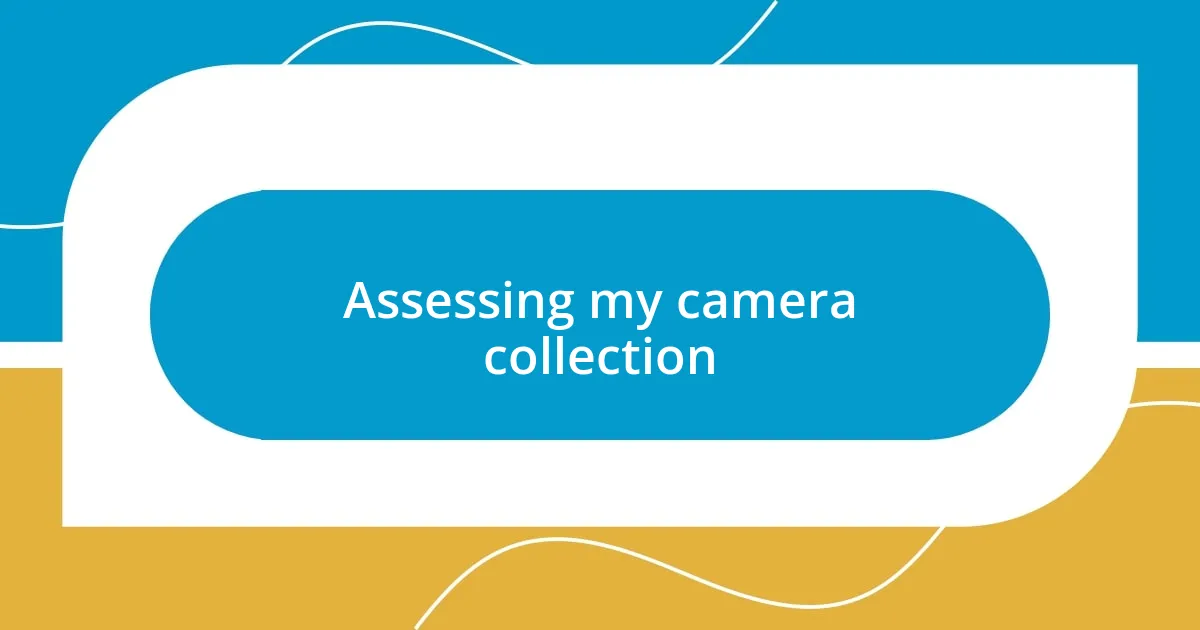
Assessing my camera collection
As I took a moment to truly evaluate my camera collection, I felt a wave of nostalgia wash over me. Each piece holds a memory, whether it’s the first DSLR I saved up for or the compact camera that accompanied me on countless adventures. Have you ever felt that connection to your gear?
When I sorted through my collection, I realized it wasn’t just about the number of cameras but the stories behind each one. I found my old film camera buried at the back of the shelf, a reminder of the excitement of waiting for film to develop. It made me wonder, how many of us cherish the past but overlook how it shapes our present photography?
I noticed that some cameras were gathering dust, and that prompted an honest assessment of their value to me. I asked myself—am I truly using each piece to its fullest potential? Realizing that some gear served purely as decor opened my eyes to what I could let go of, allowing me to envision a more focused and purposeful collection.

Choosing the right storage solution
Choosing the right storage solution for my camera gear was a bit like finding the perfect home for a beloved pet. I needed something that not only kept my equipment safe but also allowed me easy access when inspiration struck. I remember standing in an aisle full of storage options—cases, bags, shelves—and feeling overwhelmed. But I quickly realized that the right choice depended on how I used my gear.
When deciding on a storage solution, consider these factors:
- Accessibility: How quickly can you get to your gear? Look for options that allow easy retrieval.
- Protection: Does the solution offer enough padding and security against drops or spills?
- Portability: Will you need to take your gear on the go? A lightweight, compact option might be best for travel.
- Organization: Does it allow for efficient arrangement of different items, like lenses, filters, and cameras?
- Space: How much space do you have at home? Measure your area before shopping to find a fitting solution.
I vividly remember the day I opted for a sturdy shelving unit over a traditional camera bag. It was a game changer. Now, instead of fumbling through bags to find a lens or tripod, everything has its place. I feel a sense of pride as I gaze at my organized setup, knowing that I’ve made the most of my space, both creatively and practically.
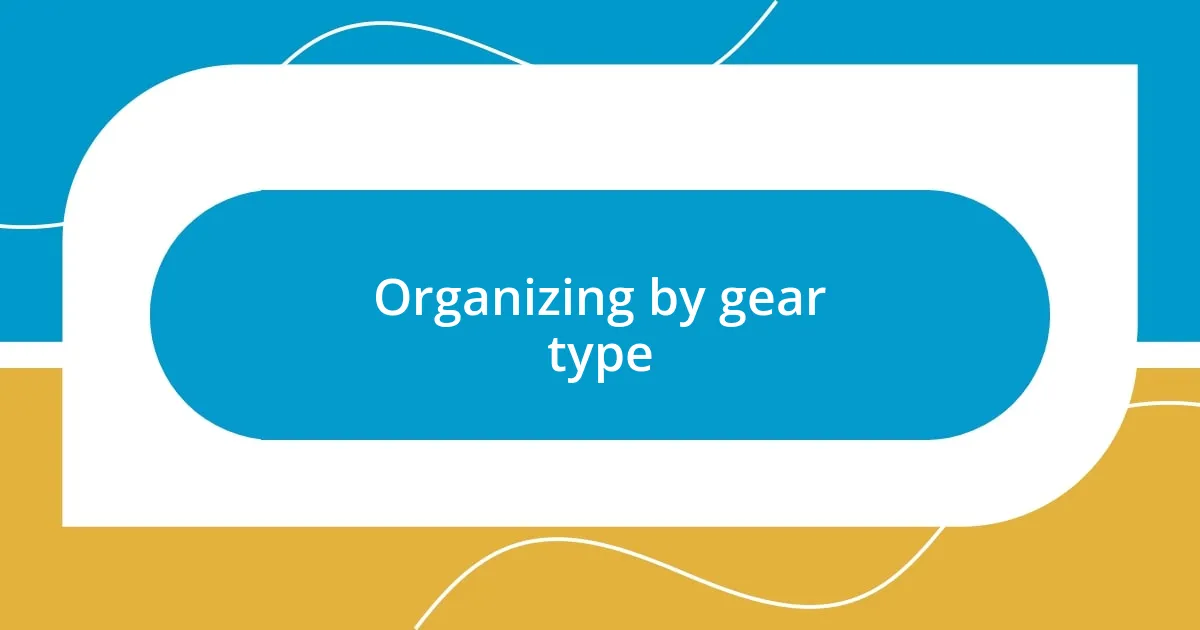
Organizing by gear type
When I divided my gear into these categories, I noticed how much simpler it became to find exactly what I needed in a pinch. For instance, storing my lenses together not only preserved their safety but also helped me quickly identify which one would best suit my next shoot. I found myself smiling as I reached for my favorite portrait lens, recalling the magic I created with it at my cousin’s wedding last summer.
This method also revealed gaps in my collection. During one of my organizing sessions, I found myself thinking—how often do I reach for my filters? Not often enough! This reflection inspired me to seek new ways to incorporate them into my work, leading to a renewed exploration of my creativity. Organizing by gear type wasn’t just about neatness; it was about reigniting my enthusiasm for each piece of equipment.
| Gear Type | Example Items |
|---|---|
| Cameras | DSLRs, Mirrorless, Film Cameras |
| Lenses | Wide-Angle, Telephoto, Prime |
| Accessories | Tripods, Filters, Camera Straps |
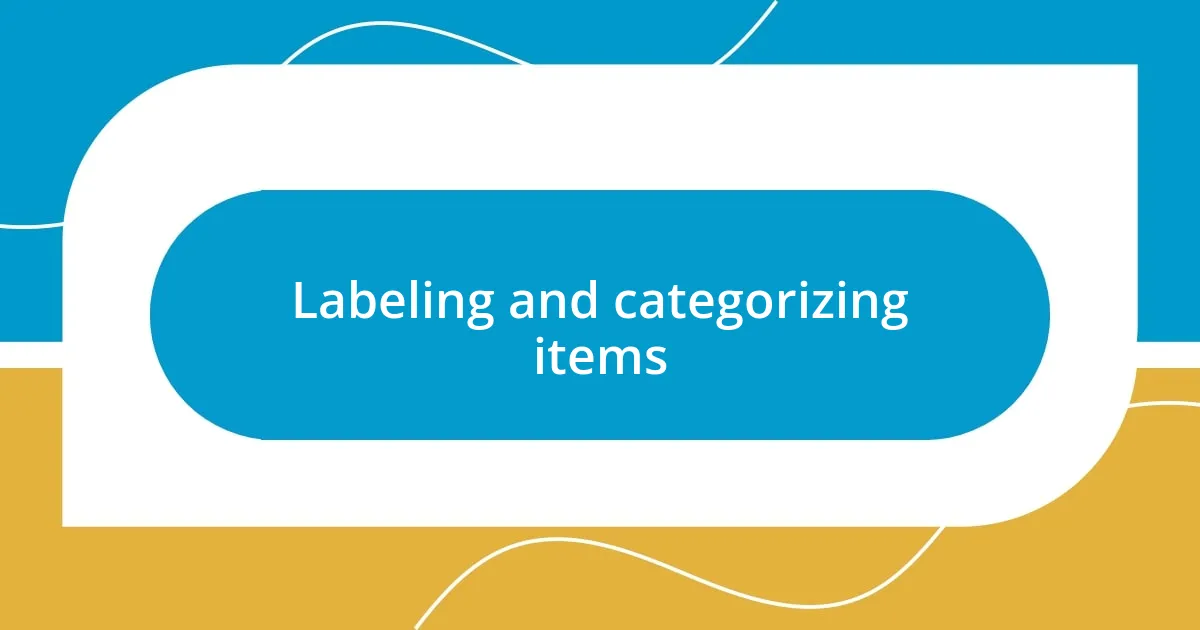
Labeling and categorizing items
Once I decided to label my items, the organization game truly stepped up a notch. I bought a label maker, and it felt like I had a new superpower. Each label represented not just a category but a memory or purpose. When I looked at my power bank, labeled and neatly stored, I remembered the late-night shooting session under the stars where it saved the day. It’s incredible how something as simple as a label can evoke those moments, making the task of finding equipment more a stroll down memory lane rather than a scavenger hunt.
Categorizing my gear wasn’t just functional; it also brought a sense of order and calm to my space. I remember the chaos of my early photography days. Lenses were scattered everywhere, and I would often waste precious time digging to find the right one before a shoot. With labels like “Portrait Lenses,” “Landscape Lenses,” and “Special Effects,” I could grab what I needed without the usual frantic search. It’s not just about knowing where things are; it’s also about enjoying the process when creativity strikes unexpectedly.
Exploring subcategories for specific items can be both fun and beneficial. For example, I created sections under “Accessories” for my filters based on their use—ND filters, polarizers, and special effects, all waiting in their organized little home. This not only made my setup look cleaner but also sparked a realization: how often had I underutilized these filters? By labeling them, I not only found them faster but rekindled my interest in experimenting with them in future shoots. It’s a small change, yet it brought a whole new vibe to my photographic journey.
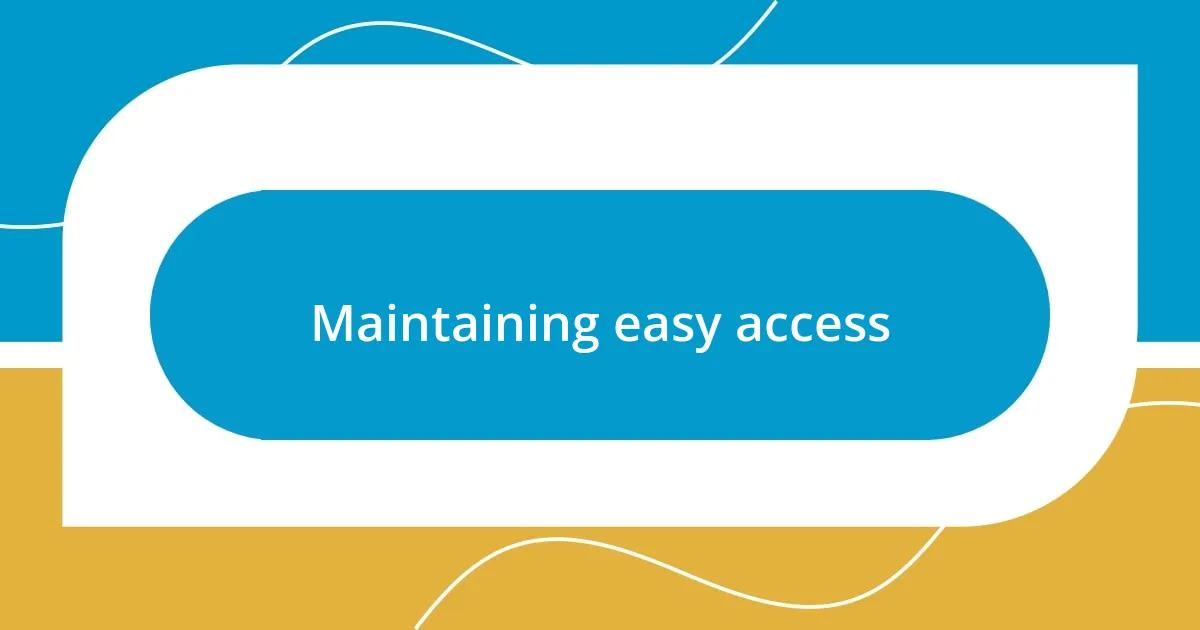
Maintaining easy access
Maintaining easy access to my gear has been a game-changer in my photography workflow. I installed a dedicated shelving unit in my studio, and that decision alone has made a world of difference. Imagine reaching for my tripod after a long day, and instead of rummaging through a disorganized pile, I find it waiting at arm’s length, ready for action. There’s something undeniably satisfying about that!
To ensure everything is within easy reach, I’ve also created a “grab-and-go” bag that houses my most-used items. Whenever I embark on a spontaneous outdoor shoot, I know exactly what to take with me. This bag has become my trusted companion, stocked with essentials like my camera body, a couple of favorite lenses, and a reliable battery pack. I often ask myself, “What do I need on this adventure?” This mindset not only saves time but also brings a sense of readiness to each outing.
Lastly, I’ve embraced the concept of having a designated spot for frequently used accessories, like filters and memory cards. When I can quickly access them, it enhances my creativity, allowing me to focus on capturing the moment rather than searching aimlessly. I recall a sunset shoot where I needed a specific ND filter. With everything organized, I found it instantly, and that efficiency led to some of my favorite shots. It’s remarkable how a little organization can lead to magical moments in photography!

Regularly reviewing and updating setup
Regularly reviewing and updating my setup has become a vital part of my photographic routine. I often schedule a monthly “gear audit,” where I assess not just the physical condition of my items but also their relevance to my current creative pursuits. During one of these audits, I stumbled upon a forgotten lens that sparked a wave of inspiration; I had to immediately plan a shoot around its unique qualities.
As I reflect on my gear’s journey through different projects and personal growth, I realize that my needs change over time. For instance, my focus has shifted from wildlife photography to urban landscapes, and with that comes the need to reevaluate which items truly serve my evolving vision. While going through my accessories, I was surprised to find some items that felt stale—like my old, mismatched filters. It was a subtle nudge to let go and make room for fresh creativity.
Engaging in this regular process creates a deeper connection with my gear. It’s not merely about checking boxes or tidying up; it’s like curating a collection that reflects not just who I am as a photographer, but also where I want to go. I often ask myself, “What stories do these pieces tell?” Each item has its history, and updating my setup renews my excitement to explore those stories. It turns this task into an invigorating journey rather than a mundane chore, making me eager for the next shoot.


